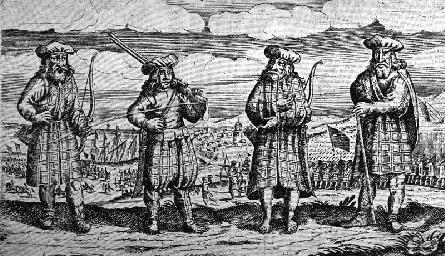|
-
9th November 07, 01:41 AM
#1
Why the kilt is as it is today, I do not for certain know, I imagine it is a standardised, formalised garment developed from the belted plaid.
These images show several examples of how the plaid could be worn, with all of it hanging from the belt, near the floor, with it up around the shoulders for warmth, or gathered and over one shoulder to keep it out of the way. Also, the second fellow in the second picture has the plaid bound around his legs from the knee down, turning them into something like pants.


The plaid was essentialy a large rectangle of cloth, simple and utilitarian. it was an item for every occation. Remeber that in those days, travel was normaly done by foot, and would take several days. Often, this would mean sleeping under the stars, with the the huge amount of blanket to keep you warm. This (I think) is the reason for it being wool, as wool will keep you warm even when it is wet, thats why sheep dont die of hypothermia when it rains.
The reasons for the pleats are several fold, yes, they do add more layers and more insulation, but also, they keep the large amount of fabric well ordered, neat and easy to wear, rather then being all bundled up somewhere. The pleats also alow fantastic freedom of movement, alowing the bottom apature of the kilt to open just as far as you like.
Aprons, (again, i'm making assumptions, so feel free to correct me if you know differantly) as the plaid was a sheet of cloth, rather then a tube, it was important to have some overlap to protect your modesty, perhaps having pleats all the way around the front would be just too much fabric there to be comfortable.
When worn was one normaly imagines the plaid was worn (belted at the waist, hanging to the knees with the rest over a shoulder) it is easy to see where the modern kilt comes from. Simply remove the fabric above the belt, and sew the remainder to keep the pleats where they are, making a more practical and easier to don, garment.
PS this report is pure assumtion, based upon knowlege gathered here and there.
Sources;
Here, mcgurk 2007,
There, mcgurk, 1983-2007
-
-
9th November 07, 02:04 AM
#2
One of the worst things about this picture is that the man's frumpy outfit is emphasized by the sleek silhouette of the lady opposite him. I rather like her outfit!
As for the practical origins of the kilt/belted plaid, I would agree with points already made. Keeping it above the knee allows it to remain dry when walking through damp underbrush (it's easier to dry out/put on a new pair of socks once indoors), and the pleats create an accordion-like effect which allows the greatest freedom of movement of any garment. The aprons need to be flat because it would have been too difficult to maintain front pleats while belting on the plaid.
[B][COLOR="DarkGreen"]John Hart[/COLOR]
Owner/Kiltmaker - Keltoi
-
-
9th November 07, 04:50 AM
#3
Pleating counter-clockwise makes for easier sewing if you're right-handed. I believe Matt mentioned in one of his articles that there is evidence of clockwise-pleated kilts prior to sewn-down pleats.
One of these days I'm going to make a left-handed kilt. It will be easier for me to handsew, and the pleats will take to driving better.
-
-
9th November 07, 05:40 AM
#4
 Originally Posted by McGurk

Also, the second fellow in the second picture has the plaid bound around his legs from the knee down, turning them into something like pants.

Actually, he is wearing pants, that's not a belted plaid. The other three soldiers there are wearing belted plaids.
I think the basic question here is "why does the fact that this garment is ful-length mean that it is not a kilt?" Which brings us to the perennial question of "what defines a kilt?" And this is a tough nut to crack.
Here is an article I have written on that topic:
http://albanach.org/define_kilt.htm
I think in this case one can point to historical precidence of the kilt always been knee length, plus or minus, for men. This is one constant part of tradition. So making the kilt so obviously outside of the norm in this case is going to cause many to question it being a kilt at all.
The length of the garment seems as essential to its being classified as a "kilt" as the fact that it is pleated. How many of us would call a staight A-line skirt, knee length and even made from tartan, a "kilt" if there were no pleats?
Aye,
Matt
-
 Posting Permissions
Posting Permissions
- You may not post new threads
- You may not post replies
- You may not post attachments
- You may not edit your posts
-
Forum Rules
|
|


















Bookmarks